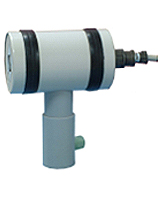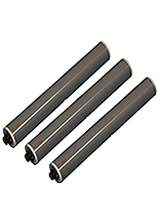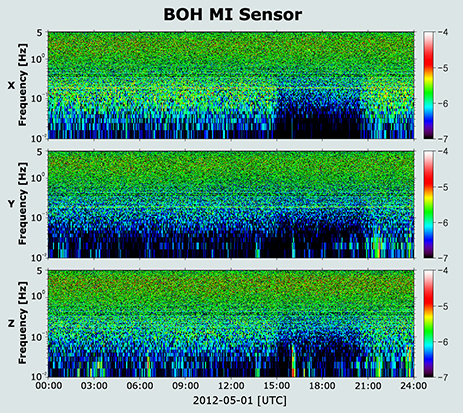Magnetometer
Since 2007, Korea Astronomy and Space science Institute (KASI) has been operating three types of magnetometers (fluxgate, proton sensor and MI magnetometer) in order to investigate the effect of the solar storm in the Earth. Magnetometers are very effective to study the arrival of the geomagnetic storm and space weather variations.
Fluxgate magnetometer
Fluxgate magnetometer is fundamental to study the geomagnetic storm effect by using the 3-axis component observation of the Earth’s magnetic field. This instrument is now real-time monitoring the space weather by measuring the Earth's magnetic field variation and operating 24 hours continuously. This equipment is operated unattended.

| Sensor Type | Ring core type |
|---|---|
| Measuring Range | -65,000 nT ~ 65,000 nT |
| Resolution | 0.01 nT |
| Temp. stability | 0.2 nT/℃ |
| Measuring Interval | 1 second |
Overhauser effect proton sensor
Proton sensor is being operated in conjunction with fluxgate magnetometer and measuring the total magnetic variation of the Earth’s magnetic field. This equipment is also operated 24 hours and unattended.

| Sensor Type | Overhauser effect proton recession |
|---|---|
| Measuring Range | 30000nT∼70000nT |
| Resolution | 0.3nT |
| Temp. stability | 0.1nT |
| Measuring Interval | 5 second |
Below shows the magnetic field variations from fluxgate and proton sensor magnetometers. The bar graph overplotted with Z component of the fluxgate magnetometer is a local K index calculated from the BOH magnetometer data. Originally the K-index is a value related to the maximum fluctuations of horizontal components from the fluxgate magnetometer relative to a solar quiet day (SQD) during a three-hour interval.
![BOH Magnetic Field Data 2012-04-30 ~ 2012-05-01 [UTC]](/resources/images/contents/img-magnetometer03.jpg)
Fluxgate magnetometers' H, D, Z components
(from top to third panels), local K index from BOH magnetometer (third panel) and proton magnetometer data (bottom panel)
MI magnetometer
MI (magneto-impedance) sensor is a relatively new type of magnetometer that measuring the wide frequency power spectrum of the Earth's magnetic field. We can get the wave information by using Fourier transformation of the observations.

| Sensor Type | Magneto-Impedance |
|---|---|
| Compensation Field Range | ±80,000nT |
| Noise | 1pT/√Hz |
| Measuring Interval | 10 Hz |
| Data Record Format | Binary 12byte/record |
| Operation System | UNIX |
Below shows the power spectrum in the frequency domain from 3-axis magnetic field observation of the MI sensor. The vertical axis is the frequency (Hz) range, The color bar indicates the power corresponding frequency. From MI sensor's spectrum, we can get valuable information on the waves which might take an important role to modulate the wave-particle interactions in the Earth' magnetosphere.

BOH MI sensor data, real time-monitoring screen
